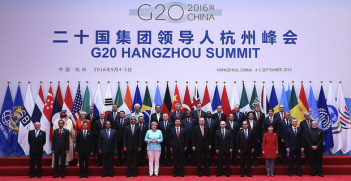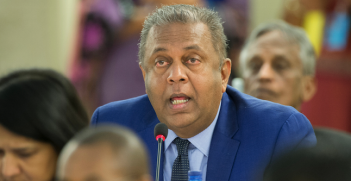Boosting Economic Growth and Trade
With the B20 being held this week, the Australian Minister for Trade and Investment, the Hon Andrew Robb MP, outlines his plan for ramping up the nation’s economic growth, increasing trade and instituting badly-needed reform.
Australia can only continue to hold its own in the adjusted regional economy if we engage in the necessary structural reforms to promote economic growth, now and into the future. As a government, we are pursuing an ambitious trade and investment agenda. Our central objective is to displace big government from the centre of economic policy and replace it with robust growth driven by the private sector.
To guide our approach, we have embraced four key but powerful principles:
- We will live within our means.
- We will pursue serious deregulation.
- We will restore a culture of personal responsibility – both for individuals and corporations.
- And we’ll back our strengths: things we do well as a nation and better than most.
We are also restoring the government budget back to health after a record build-up of debt and deficit under our predecessors.
Reversing the growth in debt will stop the financing of government bonds from crowding out the financing of our small and medium-sized businesses, who are the innovation centre of our economy.
Making changes
Reform-wise, we are focussed on reducing the costs of doing business in Australia to provide certainty and stability. Cutting red and green tape, we have identified around 10,000 laws and regulations for repeal.
Streamlining project-approval processes, we are seeking to fully reverse the up to twoyear blow-out in approval times for major projects. Since taking office we have granted environmental approval to 125 projects worth $400 billion, some which had been delayed for six years. We are also removing ineffective, highly regulatory, anti-competitive taxes, such as the carbon and mining taxes.
We are restoring the Australian Building and Construction Commission (ABCC) to boost productivity and restore the rule of law in the construction industry. We have also taken a series of difficult decisions to end government hand-outs to underperforming enterprises – for example, in regard to SPC, Qantas and Holden.
We are committed to this reform agenda and its implementation, and we have made significant progress since coming to office, and I look forward to sharing our blueprint for reform with my G20 counterparts.
Promoting trade
What I am discovering around the world is a disillusionment with a lot of the interventionist policies that followed the Global Financial Crisis. There is a realisation that these highspending, high-regulation responses are not delivering the sustainable economic growth sufficient to reduce unemployment. This explains – especially in the developed world
– the move to focus on greater trade and investment as drivers of growth.
Many countries are not waiting for the World Trade Organisation (WTO) to deliver effective multilateral outcomes, but it is important to not desert the WTO process because of its critical role in setting and fostering global trading rules. Rather, globally we are now seeing a plethora of bilateral, plurilateral and regional free-trade agreements, including our successful deals with South Korea and Japan.
Australian success stories
Australia has seized the advantage. We are the first major agricultural producer to conclude a substantial trade agreement with Japan. A vastly superior deal to that secured by anybody else, it opens up a wide range
of new opportunities and delivers the world’s best access to the region’s second-biggest economy – one with a GDP of over $5 trillion and a population of around 128 million.
We are also making progress on freetrade agreements with China, and working strongly to complete the regional Trans Pacific Partnership (TPP) agreement with 12 Asia-Pacific countries. As well, we are at various stages of engagement in the Trade in Services Agreement (TiSA), the Regional Comprehensive Economic Partnership (RCEP) agreement, the Pacific Agreement on Closer Economic Relations (PACER Plus), the Information Technology Agreement (ITA), the Environmental Goods Agreement, and of course, Doha Round negotiations continue.
Australia is also pursuing a plurilateral agreement with the Gulf Cooperation Council, bilateral agreements with Indonesia and India, and doing scoping work this year in regard to the European Union.
Turning the tide
To me, the myriad smaller agreements, including the bilaterals, are important in our trade landscape. Like bricks in a wall, they prompt important structural changes in countries. They are not multilateral agreements. They are not perfect. But over time we start to see a lot of liberalisation in participating countries, a lot more structural change, and so, as we build the wall, we head towards a multilateralised result.
And to the naysayers who invariably pose the question: “What is the value of these so-called free-trade agreements?” Just take a look at the Closer Economic Relations Agreement between Australia and New Zealand. This agreement is one of the most comprehensive bilateral freetrade agreements in existence, covering substantially all trans-Tasman trade in goods, including agricultural products, and was the first to include free trade in services.
Since it began in 1983, over 20 years ago, the two-way trade in goods between the two countries has expanded at an amazing average annual growth rate of 8 per cent each and every year – an average 8.9 per cent growth in New Zealand exports to Australia, and 7.5 per cent growth in our exports to NZ. The results say it all. And each year, ministers from across the Tasman meet to determine more ways to increase the comprehensiveness of the agreement.
Under new management
So, as a new government in Australia, with trade and investment now centre-stage and a preparedness to make structural changes, we are trying to send a signal to show that we want to do business.
This story is exemplified by the Korea- Australia Free Trade Agreement (KAFTA), a landmark deal that I had the honour of signing three weeks ago in Seoul. Economic modelling predicts KAFTA will create more than 15,000 jobs in Australia between 2015 and 2030, and that excludes the gains that will flow for services. It will also add about $650 million dollars per year to our economy when in full force. Importantly, it also puts us back on a level playing field with competitors like the US, EU, ASEAN and Chile, which up until now have had a competitive advantage with their FTAs with Korea.
These aren’t agreements for agreements’ sake – they are major advances for our economy. Steps that create real jobs, lower prices and higher living standards for consumers, and contribute to sustainable growth. And they result in important structural adjustment in all three countries.
As Australia’s first Minister for Trade and Investment, I have an important remit. One that intrinsically links our trade decisions to increasing our investment potential and promoting the strengths of our people and our nation. One to position Australia as a competitive regional economy within the Asia-Pacific region and the world.
The Hon Andrew Robb AO MP is the Minister for Trade and Investment.
This is an extract from G20: Words into Action Brisbane 2014, to be published by Faircount Media in association with the Australian Institute of International Affairs in October 2014.





